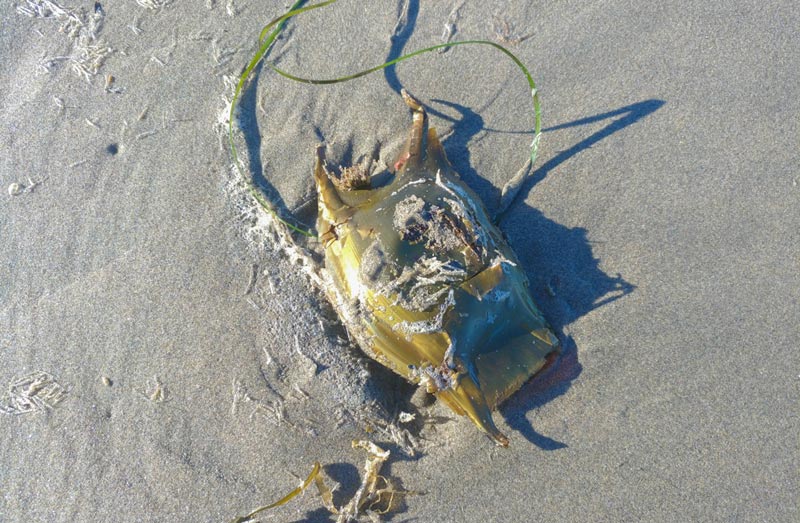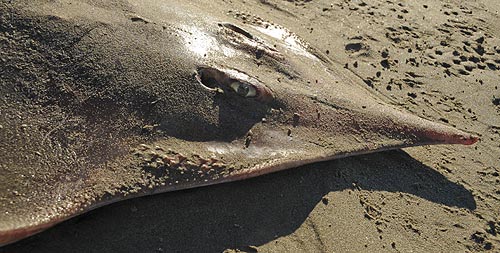'Mermaid' Purses Found on Oregon Coast Lately Could Yield Life
Updated 10/31/20 at 5:41 AM PDT
By Oregon Coast Beach Connection staff

Includes exclusive listings; some specials in winter
In Cannon Beach:
Includes rentals not listed anywhere else
In Manzanita, Wheeler, Rockaway Beach:
Some specials for winter
In Pacific City, Oceanside:
Some specials for winter
In Lincoln City:
Some specials for winter
In Depoe Bay, Gleneden Beach:
Some specials for winter
In Newport:
Look for some specials
In Waldport
Some specials for winter
In Yachats, Florence
Some specials for winter
(Yachats, Oregon) – A run of reports of something unusual has numerous beachcombers puzzled lately on the Oregon coast – or at least it was happening earlier this month. Sizable, dark brown purse-like objects have been reported in some areas (according to one notice from the Cape Perpetua Marine Reserve), just lying around the beaches, certainly in the Yachats area. (Photos Seaside Aquarium's Tiffany Boothe).
You’ll also, of course, find them along the Washington coast.
Sometimes they’re called mermaid purses, but mostly their real name is skate egg casings and they’re roughly about a foot long. Stranger still, they can actually have live eggs left inside, little white blobs that will one day hatch into actual longnose skates. These are long, sleek creatures that get about two or three feet long (known as Raja rhina), and their dried bodies periodically wash up. Sometimes it’s the casings of Big skates which are found (Raja binoculata).
Skate egg casings are made of thick collagen proteins and to the average person they’ll likely feel like plastic. Inside, they have two to seven egg embryos, although most of the time if they’re found on the beaches of the Washington coast or Oregon coast they’ve dried out or been tossed around too much to be still living.
When the right one is found by the right agency, these can hatch. Seaside Aquarium has been picking them up periodically since the early 2000s, and several have hatched into baby skates over the years, which have then been put on display.
“They probably have about six months before they are ready to leave their protective casing,” said Tiffany Boothe with the Seaside Aquarium. “Until then they cannot be on display. Their eyes are sensitive to light at this stage.”
Skates tend to reproduce later in life than many species, Boothe said.

“Adult female skates will drop these on the ocean floor, where the casing will drift for nine to twelve months,” Boothe said. “During that time, the embryos feed upon a yolk sack that they are attached to. When the babies are developed enough to be self-sufficient, one end of the casing will open up and the baby skates will emerge.”
The Hatfield Marine Science Center in Newport has had some luck bringing these to life as well. In early 2019, a visitor brought an egg casing by and biologists immediately noticed there wasn’t the telltale, dead fishy smell. They cut out a section and saw some movement in the embryos. They later replaced that cut-out section with an acrylic window so they could watch the embryos’ development, and placed it in a tank. Four months later, four male skates were born.

This happened several times over the years at the facility in Seaside.
West winds bring these unique, pointy sacks onto beaches, among other things, and late August saw a small rush of other creatures and objects as well. However, normally it’s winter or spring that creates the “ocean burps,” which is the name for when the ocean tosses a large variety of debris and marine life onto the sands. A late summer run of this is a bit unusual.
It's further proof that you should continue looking down while at the beach. You never know what you'll find. Oregon Coast Hotels for this event - Where to eat - Map - Virtual Tour
Cannon Beach Lodging
Nehalem Bay Lodgings
Manzanita Hotels, Lodging
Three Capes Lodging
Pacific City Hotels, Lodging
Lincoln City Lodging
Depoe Bay Lodging
Newport Lodging
Waldport Lodging
Yachats Lodging
Oregon Coast Vacation Rentals
Oregon Coast Lodging Specials

More About Oregon Coast hotels, lodging.....
More About Oregon Coast Restaurants, Dining.....
LATEST Related Oregon Coast Articles
A curious weather phenomenon that happens more out here
Curb, Road Construction Resumes in Lincoln City as Oregon Coast Season Begins...
Crews return Sept 15 with some dust and small delays. Traffi
NASA Announces First Evidence of Life on Mars in Possible Biosignature
In a former riverbed billions of years old, they found spots with interesting compounds. Astronomy
Portland, Oregon - Beaverton, Oregon Weather and Alerts | Current Conditions,...
Current weather conditions and alerts for Portland and Beaverton
Oregon Coast Scenic Railroad's Fame Engine Turns 100 Years Old with Special Runs
Sept 20 and 21 various special rides. Garibaldi events, Rockaway Beach events, Wheeler events
South Oregon Coast Goes Interstellar: Coos Bay's Sunset Bay Astronomy Fest Se...
Shore Acres State Park gets spacey. Coos Bay events
Swarm of 12 Quakes Fire Off 100 Miles from South Oregon Coast
After the initial 5.8, ranging in magnitude from 2.7 to 5.1: Coos Bay, Port Orford, Bandon, Gold Beach. Geology, weather
SOLVE Cleanup Happens Along Oregon Coast, Inland Sept 20 Through 28
SOLVE is inviting volunteers to take part. Brookings events, Gold Beach events, Port Orford events, Coos Bay events, Bandon events, Florence events, Yachats events, Newport events, Lincoln City events, Rockaway Beach events, Manzanita events, Cannon Beach events, Seaside events, Astoria events
Back to Oregon Coast
Contact Advertise on BeachConnection.net
All Content, unless otherwise attributed, copyright BeachConnection.net Unauthorized use or publication is not permitted
















































